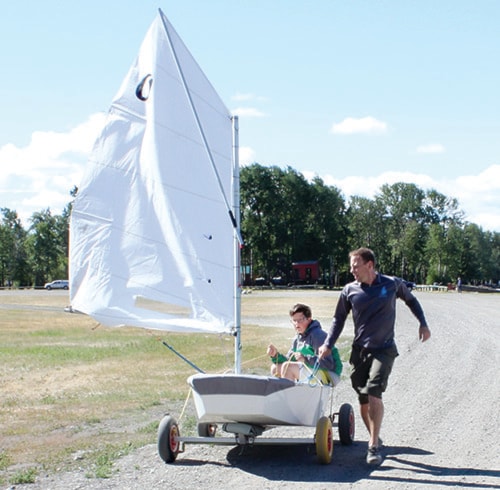Fort St. James -- BC Sailing Association's summer camp for kids was held last week in Cottonwood park and provided participants a fun way of learning all the ins and outs of sailing.
The personal aim of sailing instructor Chris Carberry,41, is to teach as many people as possible how to sail.
"Were not trying to make more business for ourselves, were actual trying to work ourselves out of a job. If we train these kids we won't have to come back," said Mr. Carberry, who has been sailing for 16 years.
Each year the BC Sailing Association holds summer camps throughout the province to teach young sailors the basics on launching, docking, steering, balancing and propulsion.
Helping instruct the class this year was Emily Bugeja, 15, who has been racing sailboats for five years. She explained how wind between 3 to 5 knots is ideal for young ones and how It's easier for her to hike out (lean off the side to control the boat) because she's heavier.
"That's why the lighter wind is perfect for them. That way they can go through the motions of sailing without struggling to keep the boat in control," said Emily.
A few days last week had wind speeds upwards of 20 knots. Instead of being on the water during those days, the kids were shown the sailing experience on land using a specialized buggy made by Mr. Carberry who is a engineering technologist during the other eight months of the year. The kids also enjoyed regular camp games like cops-ands-robbers and some other original activities including building a super kite made from two sails tied together.
When learning to be on the water, the most commonly used words are Jybe, meaning to change direction with the stern (back) of the boat, and tack, meaning to change direction with the bow (front) of the boat. In either case, once the sail catches the wind it moves fast, so you want to be the boss, said Mr. Carberry.
"The key is to pull the rope so you know when the sail is coming," said Mr. Carberry.
On the days with low wind speeds the kids used their new-found sailing skills and the seven-foot optimist sailboats proved strong.
"It's fun to be out on the water and lean off the side of the boat with the wind in your hair," said Ross Willick,12, a camp participant. "You go quite fast."
